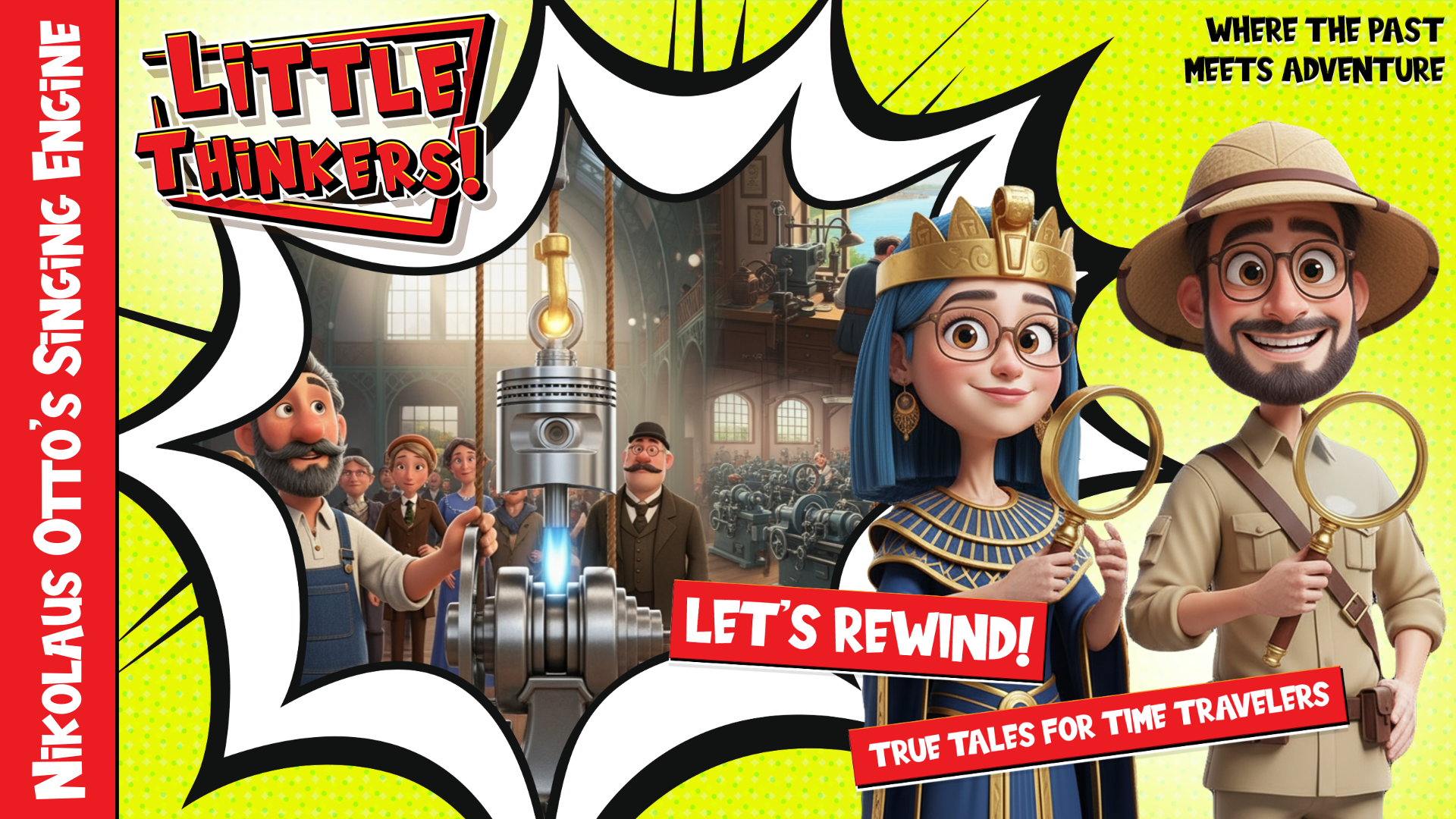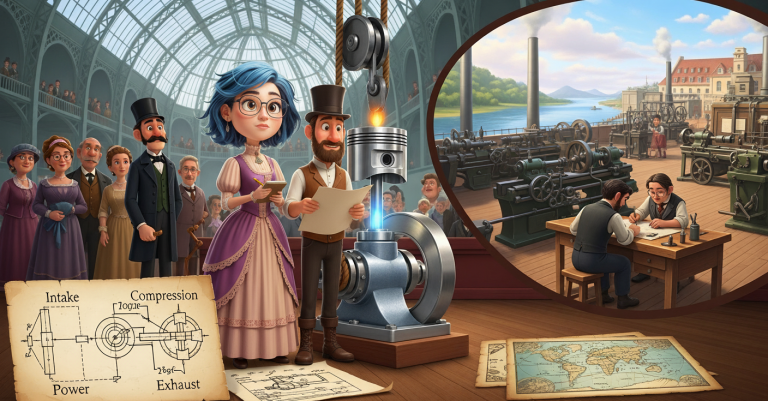The Singing Engine: Nikolaus Otto’s Amazing Journey from Salesman to Inventor
Imagine This: A Quiet Revolution Begins
Picture this: You’re walking through the streets of Paris in 1867, and everyone is buzzing about an amazing machine that runs on gas! A tall German man named Nikolaus Otto stands next to his invention, watching as it puffs softly and lifts heavy weights. The crowd gasps as gears turn and shafts spin with a careful, tidy sound. This wasn’t just any machine – it was the beginning of a revolution that would change how we travel forever!
What makes this story even more incredible is that Nikolaus Otto wasn’t even a trained engineer when he started. He was a traveling salesman with big dreams and an idea that wouldn’t let him sleep at night. His journey from a small workshop to changing the world is one of the most exciting adventure stories you’ll ever hear!
A Boy with Curious Eyes
Our story begins in 1832 in a small German town called Holzhausen. Little Nikolaus Otto was born into a modest family where every coin counted. As a boy, he loved listening to the sounds around him – wagons rattling on cobblestones, horses snorting outside, and especially the clean ring of a blacksmith’s hammer on iron. He had the kind of mind that wondered: How do things work? How do wheels meet axles? How does air feed a fire?
Even though money was tight and he couldn’t afford fancy education, young Nikolaus was always watching, always learning. He grew into a careful young man with quick hands and an even quicker mind. When he became a traveling salesman, he discovered something that would change his life forever.
A Life-Changing Discovery
In inns and train stations, Otto heard excited talk about a new invention from Paris – an engine made by Étienne Lenoir that burned gas to drive a piston. This wasn’t just interesting news to Otto; it was like a lightning bolt hitting his brain! He started filling small notebooks with sketches and ideas. The question that kept spinning in his mind like a mill wheel was: Could he make an engine that worked even better?
The Cramped Workshop of Dreams
By the 1860s, Otto had set up a tiny workshop in a cramped shed behind a house in Cologne. The roof leaked when it rained, and metal filings covered the floor. It wasn’t glamorous, but it was where magic would happen! Otto and his brother worked there after long days at their regular jobs, trying to build a better engine.
His idea was brilliantly simple but incredibly hard to build: What if you could squeeze the mixture of gas and air before the spark ignited it? This compression would make the engine more powerful and use less fuel. Sounds easy, right? Well, it definitely wasn’t!
Epic Failures and Never Giving Up
Otto’s early engines were disasters! They coughed like sick dragons, stuck like rusty doors, and misfired like broken fireworks. Flames shot out at the wrong times, pistons seized up, and valves leaked like broken faucets. Some neighbors rolled their eyes at all the smoke and popping sounds coming from that little shed.
But here’s what made Otto special: he never gave up. Every failure taught him something new. Every mistake showed him what not to do next time. Night after night, he filed metal parts, adjusted tiny pieces, lit small blue flames, and tried again. The shed smelled of oil, metal, and incredible determination!
A Partnership That Changed Everything
Sometimes the best discoveries happen when two brilliant minds meet. In Cologne, Otto met Eugen Langen, a sharp-eyed businessman who didn’t laugh at Otto’s rough engines or dismiss his crazy ideas. Instead, Langen saw the careful thinking and amazing potential behind all those sketches and numbers.
In 1864, they formed a small company called N.A. Otto and Company. But instead of jumping straight to Otto’s compression idea, they decided to perfect something called an “atmospheric engine” first. This clever machine used the pull of air pressure after an explosion lifted the piston – like a vacuum cleaner working in reverse!
The Atmospheric Engine’s Success
The atmospheric engine worked like this: A small flame lit gas in a cylinder, making the piston jump upward. Then, as the gas cooled, outside air pressure pulled the piston down hard. A clever system of gears turned this up-and-down motion into useful rotating power. Compared to other engines of the time, it used much less gas – which meant business owners saved lots of money!
Soon, these engines were humming away in breweries, flour mills, and print shops all across Germany. People loved that the engine didn’t roar and scream like steam engines. Instead, it spoke in neat puffs and steady strokes, like work itself had found a perfect rhythm.
Triumph in Paris: The World Takes Notice
Remember that scene in Paris from the beginning? In 1867, Otto and Langen brought their atmospheric engine to the Paris Universal Exhibition, where inventors from around the world showed off their coolest creations. Picture a massive hall of iron and glass, filled with the heat and excitement of hundreds of amazing machines!
When the judges tested Otto’s engine, their measuring instruments told an incredible story: this machine used far less gas than any of its competitors. The award came with public praise, and suddenly, everyone wanted one of these amazing German engines!
Fun Fact: What Made It Special?
Otto’s atmospheric engine was like the hybrid car of its time – it delivered the same power as other engines but used only half the fuel! In an age when gas was expensive and hard to get, this was revolutionary. Factory owners could cut their fuel costs in half while getting all the work done they needed.
Building a Factory by the Rhine
Success meant it was time to think bigger – much bigger! In 1872, Otto and his partners built a large factory called Gasmotoren-Fabrik Deutz right across the river from Cologne. This wasn’t just a workshop anymore; it was a real factory with stacks of iron, rows of precision lathes, and the mighty Rhine River flowing past outside.
Otto became the chief engineer, working alongside two men who would become legends themselves: Gottlieb Daimler (yes, the car company is named after him!) managed the works, and a brilliant young designer named Wilhelm Maybach drew incredibly precise technical drawings.
The factory was like a symphony of industry – belts thumped, furnaces glowed, and engines stood in neat rows waiting to be shipped all over the world. But even with all this success, Otto’s mind kept wandering back to that old dream: the compression engine.
Working Late Into the Night
After the day shift went home, a small team of dedicated inventors stayed behind. They tested new valves, experimented with different ways to mix air and gas, and tried to solve the puzzle of compression. Otto wanted to create a smooth, repeating cycle with four clean steps – but it was like trying to conduct an orchestra where every instrument had to play at exactly the right moment!
Many nights ended with tired sighs, blackened hands, and no breakthrough. But Otto knew that each failure was bringing them closer to success. The knots in this wooden puzzle were slowly giving way under their steady work.
The Morning That Changed the World
Then came a morning in 1876 that nobody in that factory would ever forget. Picture the scene: the workshop floor was swept clean, a few trusted workers stood nearby holding their breath, and Otto’s latest experimental engine sat ready for testing.
Otto turned the flywheel by hand to start the engine. Here’s what happened next, step by magical step:
- First stroke (Intake): Air and gas rushed into the cylinder
- Second stroke (Compression): The piston moved up and squeezed the mixture tighter than ever before
- Third stroke (Power): A spark ignited the compressed mixture, giving a powerful push downward
- Fourth stroke (Exhaust): The burned gas left the cylinder with a soft sigh
But here’s the amazing part – the cycle didn’t happen just once. It repeated again and again and again! The engine ran with a steady beat that sounded completely new. Every face in that room changed at once. Tired lines lifted into smiles. No one cheered – they were too amazed to make a sound. The four-stroke engine was born!
Why Four Strokes Were Revolutionary
Otto’s four-stroke cycle was like discovering a perfect recipe. Each step had to happen at exactly the right time, in exactly the right order. The compression stroke was the secret ingredient – by squeezing the air and gas mixture before igniting it, the engine got much more power from the same amount of fuel. It was more efficient, ran cooler, and lasted longer than anything that came before.
The Patent Storm
With great success comes great challenges! Otto’s company filed patents to protect their amazing invention, but they soon discovered they weren’t the only ones thinking about four-stroke engines. Back in 1862, a French engineer named Alphonse Beau de Rochas had written a scientific paper describing the four-stroke principle – but he had never built a working engine that people could actually buy.
This led to what we might call “The Great Patent Storm of the 1880s.” Lawyers and judges had to figure out: Can you patent an idea, or only the actual machine that makes the idea work? It was like trying to decide if someone could own the recipe for chocolate chip cookies or just their particular way of making them!
When the Storm Cleared
In 1886, German courts made a decision that changed everything. They said Otto’s company couldn’t have exclusive rights to the basic idea of the four-stroke cycle, because Beau de Rochas had described it first. Otto was disappointed, but something amazing happened next: this decision opened the floodgates of innovation!
Now that anyone could build four-stroke engines, inventors around the world started creating their own versions. Some made them smaller and faster for vehicles, others made them bigger and stronger for factories. It was like the idea grew wings and flew everywhere at once!
The Engine Goes Mobile
Remember Gottlieb Daimler and Wilhelm Maybach from the Deutz factory? They left to start their own workshop, where they had a wild idea: What if we could make the engine small enough to fit in a carriage? This was the beginning of the automobile age!
They worked in a greenhouse (seriously!) to create tiny, fast-running engines that could power bicycles and carriages. Their engines were like Otto’s, but shrunk down and sped up. Meanwhile, other inventors like Karl Benz were having similar ideas. The four-stroke engine was about to escape from factories and start moving people around!
From Workshops to the World
Soon, the steady rhythm of four-stroke engines was everywhere. In breweries, they stirred grain and pumped water. In mills, they turned giant stones that ground wheat into flour. In print shops, their beat could be felt in the floorboards as newspapers rolled off the presses.
The engines weren’t perfect – they needed careful attention, regular oil changes, and clean fuel. But they gave something precious in return: reliable power that didn’t need a huge steam boiler or tired horses. People learned to listen to their engines like doctors listening to heartbeats. A strange hiss meant a leak, a rattling sound meant something was loose.
How Otto Engines Work in Your World Today
Here’s the most amazing part: every time your family drives somewhere, you’re experiencing Nikolaus Otto’s genius! Most cars today still use the same four-stroke cycle that Otto perfected in 1876. Sure, the engines are much more advanced now – they have computers controlling every spark, sensors monitoring everything, and materials Otto could never have imagined. But under the hood, it’s still the same four-beat song:
Breathe in, squeeze, fire, breathe out. Breathe in, squeeze, fire, breathe out.
This cycle happens hundreds of times every minute in your car’s engine, creating the power to move your family across town in just minutes!
Otto Cycles All Around Us
Look around and you’ll find Otto’s invention everywhere:
- Lawn mowers humming in backyards
- Motorcycles leaning through corners
- Generators providing backup power
- Small aircraft engines carrying people through the sky
- Go-karts racing around tracks
The four-stroke cycle is so fundamental to our world that it’s often called the “Otto Cycle” in honor of our hero!
The Science Made Simple
Want to understand why compression makes engines more powerful? Think of it like this: imagine you’re trying to pop a balloon. If you gently press it, nothing happens. But if you squeeze it tight and then poke it, POP! – it explodes with much more force!
That’s exactly what happens in an Otto engine. By squeezing the air and gasoline mixture before the spark plug ignites it, the explosion is much more powerful. More power means the car can go faster or carry heavier loads while using the same amount of fuel. It’s like getting superpowers from being really organized!
Learning from Otto’s Example
In schools today, students learn about the Otto cycle in science class. But the real lesson isn’t just about engines – it’s about persistence, careful observation, and never giving up on a good idea. Otto spent over a decade perfecting his engine, learning from every failure and never losing sight of his dream.
Otto’s Legacy Lives On
Nikolaus Otto died in 1891, but his influence extends far beyond engines. His son Gustav became a pioneer in aviation, helping to develop some of Germany’s first aircraft. The careful, methodical approach to problem-solving that Otto demonstrated continues to inspire engineers and inventors today.
In Germany, you can still visit museums that preserve Otto’s original engines. Kids press their faces against glass cases to see massive flywheels and intricate valve systems. Tour guides demonstrate how the old engines started with hand cranks and ran on coal gas piped in from the street. These machines don’t run often anymore, but visitors can almost hear their steady breathing – the same rhythm that once filled workshops across Europe.
The Future of Otto’s Dream
Today’s automotive engineers are working on amazing new technologies. Electric motors hum alongside gasoline engines in hybrid cars. Hydrogen fuel cells promise zero-emission power. Computer-controlled systems can adjust engine timing thousands of times per second. But on laboratory whiteboards around the world, you’ll still see those same four words that Otto perfected: Intake, Compression, Power, Exhaust.
What We Learn from Otto’s Amazing Story
Nikolaus Otto wasn’t trying to become famous when he started tinkering in that leaky shed in Cologne. He just wanted to build a better engine. His story teaches us that the most important inventions often come from ordinary people with extraordinary persistence.
Think about it: a traveling salesman with no formal engineering training changed how the entire world moves. He did it through careful observation, endless experimentation, and the wisdom to accept help from partners like Eugen Langen. When setbacks came – and there were many – he kept working toward his vision.
Otto’s Rules for Young Inventors
If you want to be an inventor like Otto, remember these lessons from his life:
- Start with curiosity: Otto’s journey began with wondering “How does this work?”
- Learn from failures: Every broken engine taught him something new
- Find good partners: Langen’s business skills were just as important as Otto’s technical genius
- Be patient: It took Otto over 15 years to perfect his four-stroke engine
- Share your ideas: When Otto’s patents expired, the whole world benefited
The Engine Song Continues
Every day, millions of engines around the world continue singing Otto’s four-stroke song. In morning traffic, on construction sites, in emergency generators during power outages – that steady rhythm of intake, compression, power, exhaust keeps our world moving.
The next time you hear a car engine running, take a moment to appreciate the incredible journey from Otto’s cramped workshop to that smooth, powerful sound. Inside that engine, hundreds of tiny explosions are happening every minute, each one following the precise pattern that a patient German salesman worked out more than 150 years ago.
Otto’s story reminds us that history isn’t just about kings and battles – it’s also about curious people in workshops, solving problems that make life better for everyone. The quiet revolution Otto started didn’t happen overnight, but it changed the world forever. And the best part? His four-stroke engine is still changing the world today, one mile at a time!
Your Turn to Explore
Want to see Otto’s legacy in action? Here are some fun ways to explore:
- Visit a local car museum and look for early automobiles with four-stroke engines
- Watch a mechanic work on a car and ask them to explain the four-stroke cycle
- Find old industrial equipment in museums – many still use Otto’s principles
- Research how modern car engines are becoming cleaner and more efficient
- Think about what invention you’d like to work on for 15 years to make the world better
Who knows? Maybe you’ll be the next person to revolutionize how we move through the world. After all, every great invention starts with someone curious enough to ask: “I wonder if there’s a better way to do this?” Just like Nikolaus Otto did in that little shed in Cologne, all those years ago.













